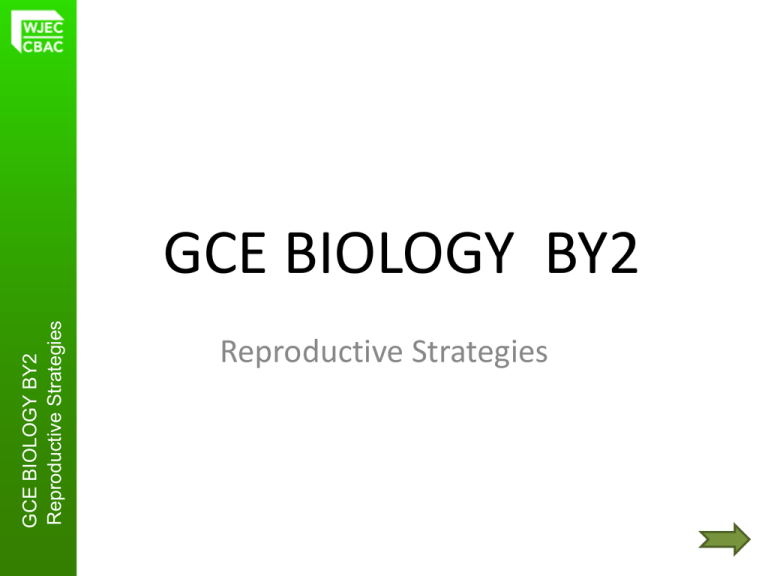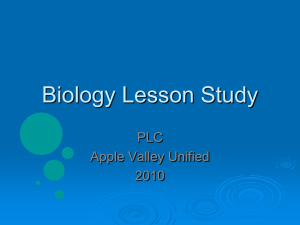
GCE BIOLOGY BY2
Reproductive Strategies
GCE BIOLOGY BY2
Reproductive Strategies
Which Came First?
Which came first?
20
19
18
17
16
OR
15
14
13
The Chicken?
The Egg?
12
11
10
GCE BIOLOGY BY2
Reproductive Strategies
9
Place your vote by clicking the
‘Chicken’ or ‘Egg’ button
8
7
6
5
4
Be prepared to
justify your choice
3
2
1
Chicken
Egg
Reproduction
What type of reproduction does this animation represent?
GCE BIOLOGY BY2
Reproductive Strategies
Simple unicellular organism
Hint: Identical offspring to the parent is produced.
Mitosis is involved.
Next: What type of reproduction?
What Type of Reproduction?
GCE BIOLOGY BY2
Reproductive Strategies
Drag the corresponding numbers to the appropriate circle to determine if
the statement relates to sexual or asexual reproduction:
1
Involves the production of haploid gametes (n)
(sex cells with one copy of each of the parents’ chromosomes)
2
Only involves mitosis
3
Produces offspring showing variation from the parent
4
Occurs when unicellular organisms, such as amoeba reproduce
Asexual
Sexual
Outline of Mitosis
Diploid parental cell (2n)
GCE BIOLOGY BY2
Reproductive Strategies
Duplication of a
Chromosome is
Followed by nuclear
division
Diploid daughter cells (2n)
Next: Outline of meiosis
Outline of Meiosis
Haploid gametes
paternal
chromosome
maternal
chromosome
GCE BIOLOGY BY2
Reproductive Strategies
2 chromatids
(n)
centromere
(n)
(n)
(n)
Meiosis
MeiosisIII
Each chromosome duplicates to form two
Diploid parent cell (2n)
Pairs of chromatids
Next: Comparison of mitosis and meiosis
Comparison of Mitosis and Meiosis
Diploid parental cell
2n
1st meiotic
division
(meiosis I)
GCE BIOLOGY BY2
Reproductive Strategies
First division
2nd meiotic
division
(meiosis I)
Diploid daughter cells
2n
n
n
n
Haploid gametes
n
The Human Life Cycle
2n
2n
mitosis
GCE BIOLOGY BY2
Reproductive Strategies
2n
n
n
meiosis
meiosis
mitosis
zygote 2n
fertilisation
This is an example of a diploid life cycle
The Human Life Cycle
Drag the labels provided to create the Human life cycle
fertilisation
GCE BIOLOGY BY2
Reproductive Strategies
sex organs
Human
zygote
gametes
adult
Plant Reproduction
diploid
sporophyte
spores
mitosis
GCE BIOLOGY BY2
Reproductive Strategies
mitosis
gametophyte
zygote
male gamete
fertilisation
mitosis
female gamete
haploid
Reproduction
GCE BIOLOGY BY2
Reproductive Strategies
Task: Compare the life cycle shown below.
Fertilisation
Compare fertilisation in a fish and humans
Human
A strong possibility that
many of the eggs will not
encounter sperm
GCE BIOLOGY BY2
Reproductive Strategies
A lot of waste with both
sexes producing a large
number of gametes
Fish
Fertilisation happens
inside the body
An intromittent organ
required to transfer sperm
into the female’s body
The Life Cycle of a Fish
adult
GCE BIOLOGY BY2
Reproductive Strategies
juvenile
spawning
Fish
fry
eggs
Larval fish
Metamorphosis: Frog
Drag the images provided to create the life cycle of a frog
GCE BIOLOGY BY2
Reproductive Strategies
The Frog
The Insect Life Cycle
Many insects change form during their lifetime - this is called
metamorphosis. They do this in one of two ways:
GCE BIOLOGY BY2
Reproductive Strategies
a) Complete metamorphosis
b) Incomplete metamorphosis
Click on the images above for a larger version of the life cycles
Next: The fly life cycle
The Insect Life Cycle
GCE BIOLOGY BY2
Reproductive Strategies
butterfly
(adult)
pupa
The Butterfly
larva
eggs
Back
Next
The Insect Life Cycle
locust
(adult)
GCE BIOLOGY BY2
Reproductive Strategies
The locust
eggs
instars
(showing
first wings)
nymph
(showing rudiment of wings)
Back
The Insect Life Cycle
Adult Fly
Pupa
GCE BIOLOGY BY2
Reproductive Strategies
Eggs
The Fly
3rd larval
stage
1st larval
stage
2nd larval
stage
Metamorphosis
Choose an insect and drag it to the ‘insect’ box below. Decide what
type of metamorphosis it has, then complete its life cycle by dragging
the appropriate labels into the correct position on the diagram:
incomplete
metamorphosis
complete
metamorphosis
pupa
GCE BIOLOGY BY2
Reproductive Strategies
adult
insect
egg
larva
metamorphosis
chrysalis
nymph










